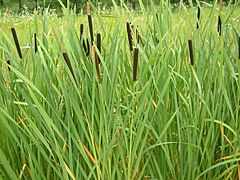Cattail facts for kids
Quick facts for kids Typha |
|
|---|---|
 |
|
| Typha latifolia | |
| Scientific classification | |
| Kingdom: | |
| Division: | |
| Class: | |
| Order: | |
| Family: |
Typhaceae
|
| Genus: |
Typha
|
| Species | |
|
See text |
|
Typha is a group of plants often called cattails or bulrushes. You can find them growing in wetlands, which are places like swamps or marshes. These plants are common in the Northern Hemisphere, but they can also be found in wet areas around the world.
Cattails are easy to spot because of their unique brown, sausage-shaped flower spikes. These spikes look a bit like a cat's tail, which is how they got their common name.
Contents
What are Cattails?
Cattails are tall, perennial plants. This means they live for more than two years. They have long, flat leaves that grow upwards from the water. Their roots grow in the muddy soil at the bottom of wetlands.
These plants are very important for their habitat. They provide shelter for many animals. Birds, insects, and other small creatures often live among the cattail stalks.
Types of Cattails
There are several different kinds of cattails. Each type has its own special features. Here are some of the well-known species:
- Typha angustifolia – This one has narrower leaves. It is sometimes called the Lesser Bulrush.
- Typha angustifolia x T. latifolia – This is a mix of two different types. It is known as a Hybrid or White Cattail.
- Typha domingensis – You can find this type in warmer, southern areas. It is called the Southern Cattail.
- Typha latifolia – This is the most common type. It is simply known as the Common Cattail.
- Typha laxmannii – This species is called Laxman's Bulrush.
- Typha minima – This is a smaller version, known as the Dwarf Bulrush.
- Typha orientalis and Typha muelleri – These types are often called Raupo.
- Typha shuttleworthii – This one is known as Shuttleworth's Bulrush.
How People Use Cattails
For a long time, people have found many uses for cattails. Every part of the plant can be helpful.
Food Source
The roots, stems, and even the young flower spikes of cattails can be eaten. Native American tribes and early settlers used them as a food source. The roots are full of starch, like potatoes. They can be ground into flour.
Building Materials
The strong stalks and leaves of cattails have been used for building. People used them to make roofs for houses. They also wove them into mats, baskets, and even chairs. The soft, fluffy seeds from the mature spikes were used as stuffing for pillows and insulation.
Water Cleaning
Cattails are amazing natural filters. They can help clean water in wetlands. They absorb harmful substances from the water. For example, they have been used to remove arsenic, a poisonous chemical, from drinking water. This makes them very useful in keeping our water clean.
Other Uses
In the past, cattails were sometimes used to make paper. However, this paper was very heavy and rough. It is not used much today. The plant's fibers can also be used to make strong ropes.
Images for kids
-
Typha at the edge of a small wetland in Indiana
See also
 In Spanish: Typha para niños
In Spanish: Typha para niños


